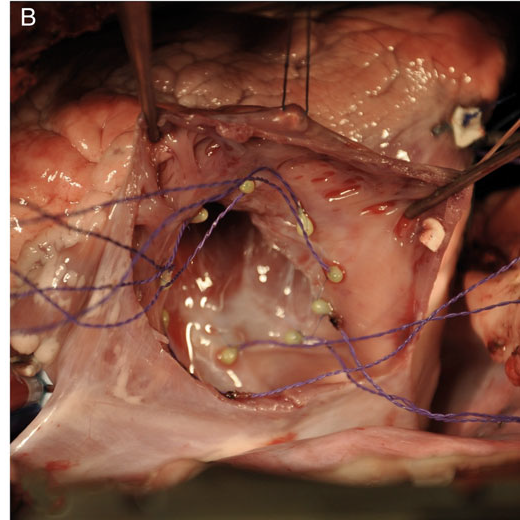Probleemstelling:
The clinical problem
Functional tricuspid regurgitation (FTR) is a clinical entity, in which the tricuspid valve is morphologically normal, but dysfunctional due to interaction with geometrical distortion of adjacent heart structures. In most cases, FTR is secondary to right ventricular (RV) dilation and pulmonary hypertension, often in relation to left-sided heart disease. Meanwhile, FTR is increasingly recognized of being responsible for increased morbidity and even mortality. From this perspective, it is recommended to correct FTR surgically concomitant to the surgical management of the primary left heart disorder. This is commonly done by geometrical remodelling of the tricuspid annulus through annuloplasty techniques, varying from the use of rigid ring devices to flexible bands and isolated suture-based annular reduction. However, their efficacy and durability remain elusive, and the TR recurrence rate up to 30% is pointing to incomplete understanding of the pathophysiological mechanisms.
Assuming that the efficacy and durability of tricuspid valve (TV) repair is strongly correlating with the stress distribution at the different main components of the tricuspid valve, a method that allows quantification of TV mechanics is required.
Available experimental data
In an animal model (adult landrace pigs), assessment of TV biomechanics is performed with the use of sonometric crystals fixed surgically on the TV annulus and free margin of TV leaflets, as well as on the outside of RV wall, with the use of a beating-heart cardiopulmonary bypass support (see figure 1-2). This sonometrics technology is based on transmitting and capting US signals between crystals, allowing the instantaneous and constant registration of extent of crystal displacement throughout the cardiac cycle. Using one exchangeable reference crystal, the amount of displacement can be plotted in a XYZ-configuration. As simultaneously, right atria land right ventricular pressure, cardiac output and heart rate is monitored, off-line digital analysis should allow to measure the stress distribution at the different TV structures in relation to the pressure-volume relationship of the RV.
Data acquisition is performed in baseline conditions, and during pressure-load induced RV failure by gradual constriction of the pulmonary artery.
In this experiment, the TV-RV interaction is studied for the normal TV dynamics. In an additional experiment, the dynamics of the normal TV are compared to TV dynamics after 3 types of used annuloplasty techniques (rigid ring – flexible band – suture annuloplasty)(see figure 3).

Figure 1 Figure 2

Figure 3